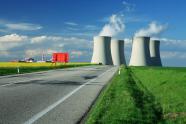Attackers Eye Nuclear Plants
Nuclear Industry Well-Prepared

While touring the grounds of Duke Energy’s power facilities that included a nuclear energy plant, this reporter was forewarned that “our every move is being monitored.” Security has always been tight. But since the terroristic acts of 2001, the precautions have become much stronger.
Since 9-11, the nuclear energy sector says that it has spent $2 billion to beef up its security to protect against everything from airliners deliberately flying into facilities to cyber attacks to armed physical assaults. While it cannot become complacent, the industry says that the efforts are ongoing and that no plant has suffered at the hands of the enemy.
“We’ve put in security to thwart any act,” says Larry Weber, chief nuclear officer for American Electric Power’s Cook Nuclear Plant in Bridgman, Mich., at a conference hosted by the Indiana Energy Association. Its top-secret measures are evaluated by the Nuclear Regulatory Regulatory Commission and its peers, as well as by the company itself that undergoes a review each year.
Among the steps taken by the plant are sophisticated detection systems that include night-time monitoring as well as newly-trained armed security forces. Meantime, the nuclear plant that comprises 6 percent of AEP’s generation, instills a corporate culture that encourages workers to raise any concerns and know that, if justified, corrective actions will be taken.
While critics acknowledge that the Nuclear Regulatory Commission has bolstered the protective measures that plant operators must take, they also say that progress is too slow. Laws enacted in 2005 require those regulators to conduct security measures every three years that examine “force-on-force” exercises, which would then trigger a shut-down of a plant.
Nuclear facilities are definitely on the minds of would-be terrorists. A memo released by the commission says that Al Qaeda has indicated that it has discussed ways to crash a plane into a nuclear power plant. At the same time, the FBI said that it uncovered information contained on a computer owned by an individual with close links to the terrorist's organization implying that nuclear units would make good targets.
Solid Defenses
Perhaps the greatest danger to nuclear plants could come from the air, or possibly by missile. At risk are the nuclear reactors and radioactive fuel deposits as well as spent fuel that is in transport, all items that regulators are charged with securing. More than half of the nation's 104 nuclear reactors are located near population centers, including two near Washington, D.C., and two close to New York City.
The purpose of a containment building is to protect the reactor core and to prevent the release of radioactive materials. Such containment walls are made up of concrete and steel. The concern raised is that a hijacked airplane could hit such a target and allow for the radiation’s escape.
That’s something that the Electric Power Research Institute says would not work as the studies show that the barriers protecting both the core and the spent fuel rods could withstand such an attack. Other experts, such as the National Academy of Sciences, agree that those plants are difficult to penetrate but not impossible.
“For the nuclear industry, our daily commitment is to remain vigilant toward security,” writes Marvin Fertel, chief executive of the Nuclear Energy Institute in the Daily Caller. “The industry, working with federal regulators and the intelligence community, receives real-time threat assessments and remains steadfast regarding security and safety.”
Terrorism is a persistent threat. So, too, are natural disasters. Just recently, nuclear plants located in the eastern United States were tested by both an earthquake and hurricane. They performed as expected and in some cases, shutting down before waiting to start back up. How does this compare with what occurred in Japan?
During the Japanese nuclear crisis in March, the back up power failed, allowing the core to melt down and to release radiation. Additionally, investigators are discovering that the Japanese suffered earthquakes in the same region that were similar in size to the one in Fukushima, and did not make the necessary modifications.
In this country, AEP’s Weber says that the redundancies set up to ensure that the fuel rods remain cooled are rigorously tested -- and that such a scenario cannot happen here. He also says that nuclear operators are looking at 500-year histories so that the plants are either modified or built to withstand the meanest natural disasters.
“I think you will see nuclear construction in the United States but there may be delay,” says Weber.
Nuclear power plants are in the eye of the storm -- literally, having been hit by tsunamis, earthquakes and hurricanes. Now the attention is broadening to include man-made attacks. In both cases, the defenses are up and the U.S. nuclear industry says that it is well-prepared.
EnergyBiz Insider has been been nominated in 2010 and 2011 for Best Online Column by Media Industry News, MIN. Ken Silverstein has also been named one of the Top Economics Journalists by Wall Street Economists.
Follow Ken on www.twitter.com/ken_silverstein
energybizinsider@energycentral.com
Copyright © 1996-2011 by CyberTech, Inc. All rights reserved.
To subscribe or visit go to: http://www.energycentral.com
To subscribe or visit go to: http://www.energybiz.com